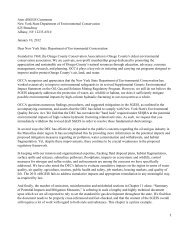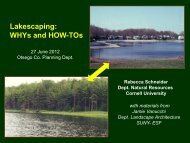Oil and Gas at Your Door? (2005 Edition) - Earthworks
Oil and Gas at Your Door? (2005 Edition) - Earthworks
Oil and Gas at Your Door? (2005 Edition) - Earthworks
Create successful ePaper yourself
Turn your PDF publications into a flip-book with our unique Google optimized e-Paper software.
REGULATIONS AND SURFACE<br />
OWNER PROTECTIONS<br />
to acquire access through good-faith negoti<strong>at</strong>ions. At a l<strong>at</strong>er time, the court will hold a trial to<br />
determine the appropri<strong>at</strong>e damages to be paid to the surface owner. Many of the disputes are<br />
settled before the cases go to court. 403<br />
Conversely, in Montana, there is no requirement for companies who hold valid mineral leases<br />
to consult with surface owners about the placement of roads, drill sites, power lines, containment<br />
ponds, or other activities th<strong>at</strong> will affect their l<strong>and</strong>. 404<br />
In st<strong>at</strong>es th<strong>at</strong> have a requirement to consult <strong>and</strong> negoti<strong>at</strong>e “in good faith,” it is often unclear<br />
wh<strong>at</strong> is meant by “good faith.” A company’s definition may differ significantly from th<strong>at</strong> of the<br />
surface owner. In Chapter IV, the l<strong>and</strong>owner story “Company’s thre<strong>at</strong> to bond-<strong>and</strong>-drill is not<br />
negoti<strong>at</strong>ing in good faith” addresses this issue.<br />
Compens<strong>at</strong>ion for Surface Damages<br />
At least nine st<strong>at</strong>es have adopted surface damage compens<strong>at</strong>ion provisions as part of their<br />
st<strong>at</strong>e laws. 405 In these st<strong>at</strong>utes, oil <strong>and</strong> gas companies typically are required to <strong>at</strong>tempt to negoti<strong>at</strong>e<br />
damage settlements with surface owners before beginning oper<strong>at</strong>ions. In most of the<br />
st<strong>at</strong>es, if the developer <strong>and</strong> surface owner cannot reach an agreement, the company has the<br />
right to proceed with development. The surface owner then has the opportunity to pursue compens<strong>at</strong>ion<br />
for damages through the court system. One notable exception is in Oklahoma, where<br />
no drilling may occur until a surface use agreement is reached or a petition is made to the court<br />
to appoint appraisers to assess surface damages. Any oper<strong>at</strong>or who willfully <strong>and</strong> knowingly fails<br />
to notify the surface owner prior to entering his or her l<strong>and</strong>, or fails to come to an agreement<br />
<strong>and</strong> does not ask the court for appraisers, shall pay, <strong>at</strong> the direction of the court, treble damages<br />
to the surface owner. 406<br />
Most surface damage st<strong>at</strong>utes truly give oil <strong>and</strong> gas oper<strong>at</strong>ors an incentive to minimize surface<br />
damages, since the oper<strong>at</strong>ors will bear the costs of any damage, not simply “unreasonable”<br />
damages (which are often difficult for surface owners to prove). In many of the st<strong>at</strong>e st<strong>at</strong>utes<br />
listed on the following page, there is a provision for “loss of l<strong>and</strong> value.” For surface owners, this<br />
is preferable to the federal damage provisions, which only apply to damages to crops <strong>and</strong> tangible<br />
improvements.<br />
In <strong>2005</strong>, Surface Owner Protection bills were proposed in four western st<strong>at</strong>es: Colorado,<br />
Montana, New Mexico <strong>and</strong> Wyoming. Only Wyoming’s bill passed. For more inform<strong>at</strong>ion on<br />
Surface Owner Protection bills <strong>and</strong> legisl<strong>at</strong>ion, contact OGAP.<br />
Site Reclam<strong>at</strong>ion<br />
Site reclam<strong>at</strong>ion of ab<strong>and</strong>oned oil <strong>and</strong> gas wells is required by all<br />
st<strong>at</strong>es, although there are some differences in regul<strong>at</strong>ions. All<br />
st<strong>at</strong>es have specific requirements for the plugging of wells to protect<br />
groundw<strong>at</strong>er, coal, gas, oil, or other n<strong>at</strong>ural resources. The<br />
definition of acceptable surface reclam<strong>at</strong>ion varies from “as near<br />
as practical to pre-oper<strong>at</strong>ion conditions” to detailed requirements<br />
for l<strong>and</strong> restor<strong>at</strong>ion, including the replacement of site topsoil.<br />
By <strong>and</strong> large, st<strong>at</strong>es do not simply assume th<strong>at</strong> companies are<br />
going to plug wells <strong>and</strong> reclaim well sites. Most st<strong>at</strong>es require<br />
companies to provide financial assurance (e.g., post a bond)<br />
before a well is drilled. This ensures th<strong>at</strong> <strong>at</strong> the end of the well’s<br />
life, if companies do not have the financial ability to plug <strong>and</strong><br />
reclaim well sites, some funds are available to enable the st<strong>at</strong>e<br />
to do the work.<br />
FIGURE II-4. THIS IS RECLAMATION?<br />
Jonah N<strong>at</strong>ural <strong>Gas</strong> Field, Wyoming, 2003. Photo by Linda Baker.<br />
II-15




